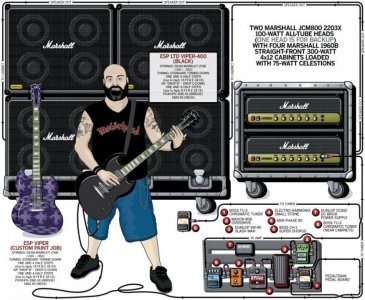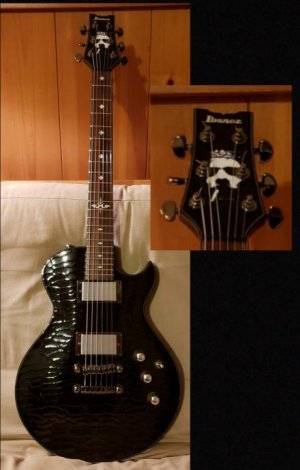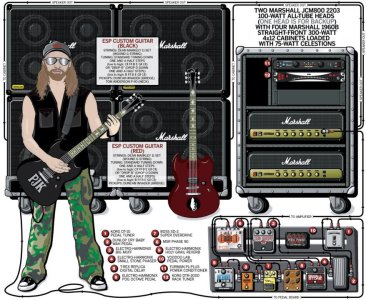Let's look at it like this. If I tell you that making great sounding pickups is as easy as taking a poop in the morning, would you buy my pickups? If I told you making great sounding pickups was harder than herding cats, that you have to sell your mother's soul to the devil, and that getting stabbed in the penis is easier, would you want to buy my pickups then?
I don't think you read my post entirely. I do mention wire gauge, tension, and layering/winding as being a part of the equation. A machine can wind the pickup as you program it to. They will scatter wind, or wind it like a fishing reel. Once you have the design and desired wind, the machine will wind it as such. A human touch is another level. Why are Abigail and Maricela so famous? Because they wrap a shitty pickup? Hell no, it's because they have a talent that most others don't. They can wrap with a level of consistency and touch that a machine and most other humans cannot. Whatever they do, it is better than what most machine made pickups can do. When they wind a pickup, it costs more to own it and it is also made to a higher standard. I said it plain as day that if we both had the exact same bobbins, wire, and everything, that if you wind it, and I wind it to the same specification, the pickups will sound different. Because you will wind it differently than I will. If you or I wind the pickup the same every time we do it, the pickup even though they are exactly the same, will impart the sound that our individual winding technique creates. The tension you use and the way you scatter the wind will be different than mine and that is what will differentiate them.
So, unless you have actually spent the time to make a pickup, you have no input that is valid beyond opinion. I NEVER said it was easy, I NEVER said it was cookie cutter. I said ( in a nutshell ) that if you know enough, you will have enough data and skill to " design " a pickup using a pretty basic palette, to achieve a goal; once you have a recipe, then it is cookie cutter. I.E. If I told Seymour himself that I want a pickup that sounds like absolute poop on a rope, he might actually have an idea of how to acquire that sound, and now that he's made that pickup, he has the recipe and can make it over and over again. If you said I want a pickup that does X, Y, or Z, I have a pretty good idea of what it will take to make that a reality.
BTW, I have done sound for Seymour Duncan and The Guitar Army a few times. I live in Santa Barbara. I have been doing this for a long time. You cannot make 100% of the people standing in the room happy. Period. And quite obviously, that statement is tongue in cheek. And if you think you can do sound so good that 10/10 will give you a 100% performance, well I have an island to sell you. Musicians are a problem looking for a solution. I am that solution. I am also a musician : ) Been playing for 27+ years! I have done sound for THOUSANDS of different bands, all over the country and abroad. I put multi-million dollar PA systems in the sky, tune them, and run them. I have worked with and for some of the worst and best bands known to man. I have completely sold the farm a few times and have had many many flawless events where I do believe that the majority of people in the room were just as happy as I was. The goal is 100% every time. I can tell you that performing to 100% is very, VERY hard. I only know one guy that I feel is a .01% performer in this field. I feel based on my many years in this field that I am setting around the 95th percentile of ability to provide the best of what your money can buy. The average sound guy is probably no better than 70%. If you are at 90% or better, you are traveling the country and beyond making a VERY good wage. If you aren't, you just do it. So yeah, I care probably more than you do about making those 7 out of 10 people happy, the goal is 10 out of 10, but as long as the person signing the check is stoked, I pretty much won already anyway; it is their money after all. I also said a good sound engineer, not a great one. I'm not a great one yet, but I am several steps above the dude down the street wearing flip flops and driving a 1990 Ford Taurus that says he is.
So to recap, the Duncan Design pickup is made to sound similar to another pickup ( of interest ) at a reduced cost. They obviously couldn't make it sound exactly like the intended selling point, or everyone would buy the cheap pickup that has no margin instead. I think at this point, that for all the popular brands, making a new pickup design is really not all that hard for them. They may have to make it a half dozen times to get the " recipe " just how they want it, but you can wind a pickup in a pretty short period of time, even by hand. I think the hardest part for any given pickup manufacturer that you know is SKU management, marketing/PR, and sales. Why do pickups or other products get discontinued? Because they aren't selling, the market has shifted to something else that has reduced demand for that product. So you have to continually make new products that are forward in the market ( predicting the future of the market if you will ), and you have to carefully manage how you will spend capital in order to push the new products. All the way down to product sponsorship and contest, giveaways, and artist relations. The R&D costs for a new pickup design are probably pennies compared to the cost of marketing, artist support, and machine programming. Seymour Duncan's Zephyr line is a good example. He told one of his top guys to go ahead and go wild. So he did. I can bet you he didn't wind too many sets of them before he settled on his " recipe ". It's not that he has much to compete with. There is no other company or person that I know of that is using silver wire to wind their pickups. But you can only screw up, or tweak the design a few times before a project like that will get scrapped. He had an idea of what he wanted and was able to get there. While I think the whole Cryogenically treated wire thing is a little over the top, the whole concept of the pickup was to be over the top. Having heard them, I think they are too bright, but if that's your bag, well, you can spend $1,500 on a set if you'd like.
So no, it's not voodoo. If you get into doing it, you will find that with some basic knowledge, you can wind a pickup to achieve a set of goals. I find it easier to know what you are referencing against. If you have a set of SL-1's and you want an SL-5 sound, well, it should be pretty easy to figure out with basic knowledge what you need to get that. I'm not saying you will do it the first time every time, but you can at least get in the dugout.




